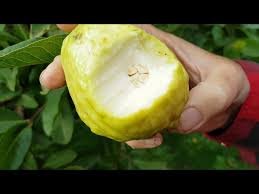 Image 1 of
Image 1 of


Castro White Guava (Psidium Guajava)
This guava originated in Cuba. I spit these seeds into a water bottle years ago in Habana Vieja while eating breakfast. Those seeds became plants that became fruit that became seeds and were harvested from Dolores T. Aaron school garden by the incomparable Amber Dawn. What is special about these plants is that they are fourth generation plants, meaning these plants are acclimated to the unique conditions of New Orleans, not trucked in from Florida or flown from California. They fruited at DTA, then the plants from those seeds fruited on France Street, and now these plants are descendants of that fruit. The power of these seedlings run deep.
The entire fruit – yellowish green peel, white flesh, and numerous seeds is edible and can be enjoyed like an apple. The white colored meat is remiscent of a cross between pear and strawberry only thicker and creamier like ice cream. and with more of a floral taste with hints of rose water. The peel is rich in phytochemicals. The more of these that we can get out in the community, the better our chances of expanding what is possible here in New Orleans. Couple these with our other offerings and we might even come up with a unique guava, born right here in this wonderful city. Guava are also reported to work symbiotically with citrus and could be planted between satsuma, lemon, or even our own unique Calaronsi and Darabi. Ask to learn more! Or go to www.crispfarmsnola.org
This guava originated in Cuba. I spit these seeds into a water bottle years ago in Habana Vieja while eating breakfast. Those seeds became plants that became fruit that became seeds and were harvested from Dolores T. Aaron school garden by the incomparable Amber Dawn. What is special about these plants is that they are fourth generation plants, meaning these plants are acclimated to the unique conditions of New Orleans, not trucked in from Florida or flown from California. They fruited at DTA, then the plants from those seeds fruited on France Street, and now these plants are descendants of that fruit. The power of these seedlings run deep.
The entire fruit – yellowish green peel, white flesh, and numerous seeds is edible and can be enjoyed like an apple. The white colored meat is remiscent of a cross between pear and strawberry only thicker and creamier like ice cream. and with more of a floral taste with hints of rose water. The peel is rich in phytochemicals. The more of these that we can get out in the community, the better our chances of expanding what is possible here in New Orleans. Couple these with our other offerings and we might even come up with a unique guava, born right here in this wonderful city. Guava are also reported to work symbiotically with citrus and could be planted between satsuma, lemon, or even our own unique Calaronsi and Darabi. Ask to learn more! Or go to www.crispfarmsnola.org
This guava originated in Cuba. I spit these seeds into a water bottle years ago in Habana Vieja while eating breakfast. Those seeds became plants that became fruit that became seeds and were harvested from Dolores T. Aaron school garden by the incomparable Amber Dawn. What is special about these plants is that they are fourth generation plants, meaning these plants are acclimated to the unique conditions of New Orleans, not trucked in from Florida or flown from California. They fruited at DTA, then the plants from those seeds fruited on France Street, and now these plants are descendants of that fruit. The power of these seedlings run deep.
The entire fruit – yellowish green peel, white flesh, and numerous seeds is edible and can be enjoyed like an apple. The white colored meat is remiscent of a cross between pear and strawberry only thicker and creamier like ice cream. and with more of a floral taste with hints of rose water. The peel is rich in phytochemicals. The more of these that we can get out in the community, the better our chances of expanding what is possible here in New Orleans. Couple these with our other offerings and we might even come up with a unique guava, born right here in this wonderful city. Guava are also reported to work symbiotically with citrus and could be planted between satsuma, lemon, or even our own unique Calaronsi and Darabi. Ask to learn more! Or go to www.crispfarmsnola.org